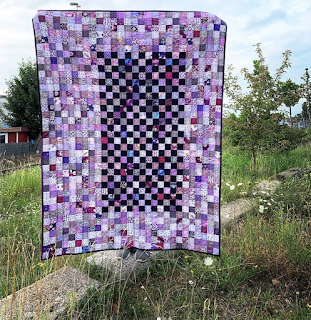16-patch with orange medallion.
72 by 72 inches
Made with over 1200 neutral (low volume) 2 1/2 inch squares pieced into 16-patch blocks.
How an idea is sparked.
When I sorted out the light 2 1/2 inch squares from the dark squares used for the Jack and Jill Round Robin Squares quilt, they sorted themselves into a pile that had me make neutral 16-patches.
I loved Kirstin Klasen's purple scrap squares with its off-center medallion. Then Wanda Hanson posted her bowties with medallions that messed with the grid.
These two ideas came together with the neutral 16-patches.
Influenced by Kirstin Klasen's purple quilt on her July 26th Instagram augusthimmel and Wanda Hanson's blog Exuberant Color August 25th bowties quilt. (screenshots taken with permission)
https://www.instagram.com/p/CDGsVb5nu45/
https://exuberantcolor.blogspot.com/2020/08/a-quilt-top.html
I first worked on graph paper to get my proportions. Moving to cloth had me re-think and I added some more blocks.
I made a pile of 16-patches, then assembled the medallion. To complete the quilt I worked my layout with the blocks showing back-sides to ensure nesting of most seams. There are a few "twisted sisters" on one side of the medallion.
This could be planned out in advance, but it worked well improvising.
I wanted the medallion to mess with the grid in two ways, that not all the squares in it line up with the 16-patches. And the medallion itself is a rectangle and is not in the exact equivalent proportions of the 16-patches.
16-patches, made from:
16 neutral 2 1/2 inch squares
Blocks finish 8 inches.
Medallion piecing: (I intended to use a stronger orange, but this soft one worked better. I am not sure of the manufacturer.)
23 orange rectangles cut 2 1/2 by 4 1/2 inches
8 orange squares cut 2 1/2 inches
THEN I added 3/4th sections of 16-patches to the bottom of the orange section so the medallion would measure 2 by 3 16-patches and it could nest into the surrounding 16-patches.
Because this was improvisational work the blocks were not assembled in rows. I did manage to make all seams nest except along one side of the medallion.
This quilt is leading to another using 16-patches made with darker squares and a different medallion.
I'll also work on a post about how I construct 16-patches with an eye for how they will nest later into a quilt.
72 by 72 inches
Made with over 1200 neutral (low volume) 2 1/2 inch squares pieced into 16-patch blocks.
How an idea is sparked.
When I sorted out the light 2 1/2 inch squares from the dark squares used for the Jack and Jill Round Robin Squares quilt, they sorted themselves into a pile that had me make neutral 16-patches.
I loved Kirstin Klasen's purple scrap squares with its off-center medallion. Then Wanda Hanson posted her bowties with medallions that messed with the grid.
These two ideas came together with the neutral 16-patches.
 |
| Kristin's quilt |
 |
| Wanda's quilt top |
https://www.instagram.com/p/CDGsVb5nu45/
https://exuberantcolor.blogspot.com/2020/08/a-quilt-top.html
I first worked on graph paper to get my proportions. Moving to cloth had me re-think and I added some more blocks.
I made a pile of 16-patches, then assembled the medallion. To complete the quilt I worked my layout with the blocks showing back-sides to ensure nesting of most seams. There are a few "twisted sisters" on one side of the medallion.
This could be planned out in advance, but it worked well improvising.
I wanted the medallion to mess with the grid in two ways, that not all the squares in it line up with the 16-patches. And the medallion itself is a rectangle and is not in the exact equivalent proportions of the 16-patches.
16-patches, made from:
16 neutral 2 1/2 inch squares
Blocks finish 8 inches.
Medallion piecing: (I intended to use a stronger orange, but this soft one worked better. I am not sure of the manufacturer.)
23 orange rectangles cut 2 1/2 by 4 1/2 inches
8 orange squares cut 2 1/2 inches
THEN I added 3/4th sections of 16-patches to the bottom of the orange section so the medallion would measure 2 by 3 16-patches and it could nest into the surrounding 16-patches.
Because this was improvisational work the blocks were not assembled in rows. I did manage to make all seams nest except along one side of the medallion.
This quilt is leading to another using 16-patches made with darker squares and a different medallion.
I'll also work on a post about how I construct 16-patches with an eye for how they will nest later into a quilt.



